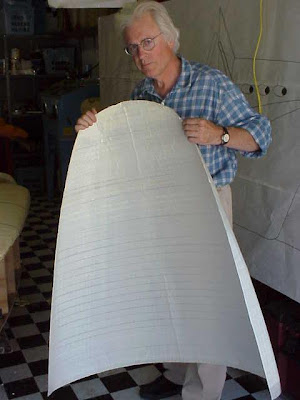We quickly became fast friends and share ideas back and forth regularly. This is the season for car work for Bill. He lives part of the year near his design studio in Juneau Alaska and part of the year near his workshop barn here in California.
Bill is one of those guys that is interested in everything. One of his passions is the history and restoration of what we know of as the "Jeep" The story is quite interesting because most people don't even know there was a army sponsored competition to find what prototype would become the iconic jeep. The first jeeps were not built by Ford or Willy's they were built by the American Bantam Car Company.
This is a picture of the first prototype built for the Army competition by the American Bantam Car Company.
There are only a handful of these first amazing prototype jeeps still around.
The secret factory barn somewhere south of San Jose. Bills barn is almost a dream shop with the exception of all the car projects in the way of machinery. He likes cars and I like machines. So I tell him to move cars out and put more machines in and he just puts more cars in. His cool man barn is located close enough to the house to prevent any excuses for not working in it, but at the same time far enough away from the living quarters and any pesky neighbors to not disturb anybody with the sounds of serious metalworking or howling engines on the test stand.
I met Bill because of a common interest in compound sheet metal shaping. These are the kinds of three dimensional curved shapes you find in automobiles and aircraft construction. My interest came from a project I had worked on that involved compound shaping of steel for a barbeque prototype. Bills interest is purely automotive. Since our first meeting Bill has steadily put together a pretty well equipped shop. As Bills personal machinery shopper I'm responsible for furthering the amount of tonnage that his wife will have to unload if he keels over one day. She should just be thankful he's not into steam locomotives is all I can say.
The machine shop bay of the barn. Standard milling machine that gets used for the restoration work of Bills car collection. The bags are covering a couple of engines waiting for assembly.
A year or so ago we found a nice Grob vertical bandsaw to cover the sawing needs in the barn. The picture on the front of the machine has a story to it. One of the first machines Bill got for his shop was a South Bend Lathe.
I was looking at old magazine advertisements on eBay one day and ran across one from WW2 that had the exact model of Southbend lathe that Bill has. In the text of the ad it said something like, "At 10 degrees South and 150 Degrees East its fix it or sink" It has a picture of a couple of navy machinery mates working on a South Bend lathe repairing a part for their destroyer steaming to attack. I thought this was a neat picture so I mounted it on foam core and gave it to Bill as a shop warming gift. I noticed its been in the shop long enough now its getting a nice machine shop patina on it after all these years.
This is one of the ways Bill keeps his creative energy flowing. Imagery is great for keeping the creative fires going.
One of the few remaining Bantam jeeps. This is a major restoration project made more difficult by the non-existence of most of the parts.
Bill has more than one car project going at a time. This is a more creative effort to re-body some old car with new sheetmetal. The wire form and screen provide an armature to create a three dimensional shape to work out the proportion in full scale and full context on the car itself. This is very hard to do on a computer screen.
Once the shape is frozen then a more permanent fitting buck was created to actually accurately develop the patterns and parts for the fender. This one is made from plywood and some bondo to fill in the more complicated areas.
Some of the shaping equipment used for compound work. The elm stump is a nice one. It has several contours carved into it that make quick work of roughing out shapes.
Bills welding area. Yes I already gave him some heat for the mess. I caught him by surprise during my surprise inspection visit so he didn't have any time to spruce the place up. The large C frame is a converted English wheel that will become a bead roller.
Its a screaming terror with the two stroke engine. There is room in the engine bay for something more interesting and modern. Maybe a GSXR motor or a small steam engine perhaps. I'm sure I will hear more about this one.
Another collection of small cars at the test grounds of the secret Bantam factory. Bill sponsored several events of Cyclekarts at his place to promote the idea of a car project that was small enough and inexpensive enough to not be out of reach of the casual hobby builder.
Hope you liked the tour.
Additional links about compound metal shaping, Bantams Bantam BRC

















No comments:
Post a Comment